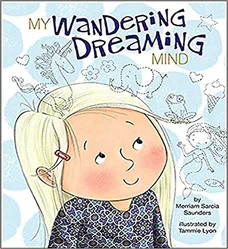My Wandering Dreaming Mind
Written by Merriam Sarcia Saunders
Illustrated by Tammie Lyon
32 pages
•
Published 2020 (Magination Press)

Recommended Age Range: Kindergarten through 3rd grade.
Publisher's Summary:
Sadie feels like her thoughts are soaring into the clouds and she can’t bring them back down to earth. She has trouble paying attention, which makes keeping track of schoolwork, friends, chores, and everything else really tough. Sometimes she can only focus on her mistakes. When Sadie talks to her parents about her wandering, dreaming mind, they offer a clever plan to help remind Sadie how amazing she is.

Dr. Annie's Takeaways
Recommended for: This book is an excellent read for children who struggle with inattention, whether in the context of ADHD or otherwise, and who will benefit from a reminder that their minds are “amazing.” Sadie is a daydreamer, and she expresses frustration that she can’t get her mind to “stay put.” Her parents remind her that her inattention comes along with many positive qualities, including being imaginative, creative, and kind.
Evidence-Based Practices:
Specific Praise
Tone: Warm, encouraging
Story Quality: This sweet story validates the frustrations of a child who struggles with inattention, and it focuses on positive qualities that often accompany inattention, like creativity and curiosity. It is warm and comforting without being cheesy or inauthentic.
Illustrations: Brightly colored watercolor and ink drawings with a lot of pattern and texture.
Representation: Sadie is a White girl with a White mom and a White dad. She has an older sister, Nicole. Sadie struggles with inattention symptoms that will likely be familiar to children with ADHD, but no diagnostic labels are used. She is a frequent day-dreamer and has challenges paying attention in class, keeping track of time, keeping track of her things, following through with chores and social commitments, and staying focused on homework. Sadie has a group of female friends with different skin colors. Her teacher has light brown skin and wavy brown hair.
Psychological Practices: This book validates the frustrations that can accompany attention challenges. After a series of inattention-related mistakes, Sadie asks her parents, “Why does my mind fly to the sky… I wish it would stay put.” Her parents remind her that she’s doing the best she can and that it isn’t on purpose. Importantly, they also remind her that her brain is “an amazing thing,” and they share examples of strengths they see Sadie exhibiting (e.g., she thinks up “fantastic stories about animals” which makes her imaginative). They come up with the idea of filling a jar with strips of paper with positive descriptors (e.g., imaginative, curious, risk-taking, kind) that Sadie can look at when she is feeling down. Kids with ADHD often make more mistakes and get much more criticism throughout their days than do kids without ADHD, which makes this intervention extra valuable.
Concerns: I wish the strips of paper had included the specific examples that Sadie’s parents shares, rather than just the more general labels. If Sadie is feeling down, she might have a hard time remembering why her parents thought that these positive traits fit her, and the specifics might be more convincing. Some of the positive labels the parents shared were not very specific either; the effectiveness would likely be improved with more specificity.
